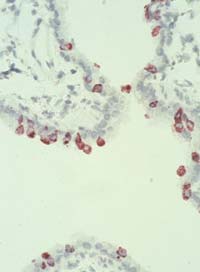Mouse antibodies thwart SARS virus

Genetic material from the SARS virus, stained red, is shown in cells lining the airways of mice. Image courtesy of Sherif R. Zaki M.D., PhD., Centers for Disease Control and Prevention. <br>
The mouse immune system develops antibodies capable of single-handedly neutralizing the SARS virus, researchers at the National Institute of Allergy and Infectious Diseases (NIAID) report in the April 1 issue of the Journal of Virology, available online March 12. NIAID is part of the National Institutes of Health (NIH).
This discovery affirms that researchers developing vaccines that trigger antibodies to the SARS virus are heading in the right direction. Vaccines can stimulate the immune system to produce antibodies or specialized cells or both to stop invading viruses.
“Since SARS emerged in people in late 2002, global public health experts have been anxiously awaiting a vaccine for this potentially fatal respiratory ailment. Knowing which arm of the immune system to trigger brings us one step closer to that goal,” says NIAID Director Anthony S. Fauci, M.D.
“This is good news for people developing vaccines that would prime the immune system to produce antibodies against the SARS virus,” says Kanta Subbarao, M.D., an investigator in NIAID’s Laboratory of Infectious Diseases and lead author on the study. “Our results also indicate that drug researchers can use laboratory mice as a model to evaluate whether a drug blocks SARS.” Both findings could help lessen the time it takes to develop an effective vaccine or antiviral drugs for SARS.
In collaboration with colleagues at the Centers for Disease Control and Prevention and the NIH Clinical Center, Dr. Subbarao’s team examined whether mice could be infected with the SARS virus and if so, how the mouse immune system responded. Initial experiments revealed that while the SARS virus did not make the mice sick, it was able to infect cells lining mouse airways and lungs to reproduce itself.
Next, the NIAID team gave a subset of the mice a second dose of the SARS virus 28 days later. This time they found that the mice produced antibodies against the SARS virus and that the virus did not replicate in the mice lungs and airways. The researchers concluded that the first infection protected them from reinfection.
In their final experiment, the researchers tested whether the antibodies the mice produced could be transferred to other mice and protect them from infection. To do so, they transferred antibody-containing serum from mice that had a previous SARS infection to uninfected mice. When these uninfected mice were exposed to the SARS virus, the virus was unable to replicate. This “passive immunity” demonstrated that antibodies alone prevented the mice from becoming infected.
NIAID researchers are continuing their work to develop a mouse model that more closely mimics SARS in people. The ideal laboratory mouse for SARS studies would exhibit the same disease symptoms as people so researchers could also use it to study how the illness progresses. The present mouse model, however, will be very useful for evaluating vaccines and antiviral drugs, Dr. Subbarao says.
The SARS virus infected 8,098 people and killed 774 worldwide between Nov. 1, 2002, and July 31, 2003, according to the World Health Organization. For more information on SARS research, see NIAID’s updated fact sheet online at http://www.niaid.nih.gov/factsheets/sars.htm.
###
NIAID is a component of the National Institutes of Health, an agency of the U.S. Department of Health and Human Services. NIAID supports basic and applied research to prevent, diagnose and treat infectious diseases such as HIV/AIDS and other sexually transmitted infections, influenza, tuberculosis, malaria and illness from potential agents of bioterrorism. NIAID also supports research on transplantation and immune-related illnesses, including autoimmune disorders, asthma and allergies.
Reference: K Subbarao et al. Prior infection and passive transfer of neutralizing antibody prevent replication of severe acute respiratory syndrome coronavirus in the respiratory tract of mice. Journal of Virology DOI: 10.1128/JVI.78.7.000-000.2004. Available online on 12 March.
Media Contact
All latest news from the category: Life Sciences and Chemistry
Articles and reports from the Life Sciences and chemistry area deal with applied and basic research into modern biology, chemistry and human medicine.
Valuable information can be found on a range of life sciences fields including bacteriology, biochemistry, bionics, bioinformatics, biophysics, biotechnology, genetics, geobotany, human biology, marine biology, microbiology, molecular biology, cellular biology, zoology, bioinorganic chemistry, microchemistry and environmental chemistry.
Newest articles

First-of-its-kind study uses remote sensing to monitor plastic debris in rivers and lakes
Remote sensing creates a cost-effective solution to monitoring plastic pollution. A first-of-its-kind study from researchers at the University of Minnesota Twin Cities shows how remote sensing can help monitor and…

Laser-based artificial neuron mimics nerve cell functions at lightning speed
With a processing speed a billion times faster than nature, chip-based laser neuron could help advance AI tasks such as pattern recognition and sequence prediction. Researchers have developed a laser-based…

Optimising the processing of plastic waste
Just one look in the yellow bin reveals a colourful jumble of different types of plastic. However, the purer and more uniform plastic waste is, the easier it is to…



